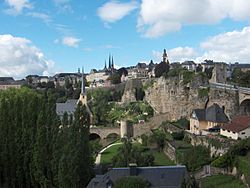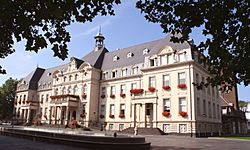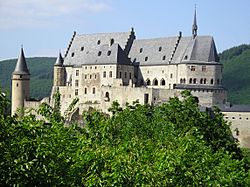List of towns in Luxembourg facts for kids
Luxembourg has twelve special places called towns. These aren't just big cities; their "town" status is given by a special law. Even though they are called towns, some of them are quite small, more like villages!
These towns are a bit like other local areas called communes. But towns have a slightly different legal status. For example, important local officials called échevins (think of them as local council members) in towns are officially chosen by the Grand Duke. In other communes, these officials are chosen by the Minister for the Interior.
What's in a Name?
In Luxembourg, a town can be called different things depending on the language:
- In Luxembourgish, it's Stad (or Stied for many towns).
- In German, it's Stadt (or Städte for many towns).
- In French, it's ville (or villes for many towns).
These words can mean "town" or "city" in English. But apart from Luxembourg City and Esch-sur-Alzette, most of these places are not big enough to be called "cities" in English.
How Towns Got Their Status
Long ago, a place became a town if it had a special document called a town charter. This was like a permission slip from the ruler. Today, towns get their status from laws passed by the government.
The first time this modern town status was given was on 24 February 1843. Seven places that used to be towns got their status back. These were:
For over 60 years, no new towns were added. But then, many people started moving to Luxembourg in the late 1800s. This meant changes were needed!
So, on 29 May 1906, Esch-sur-Alzette became a town. Then, on 4 August 1907, four more places became towns:
One area called Hollerich-Bonnevoie also became a town for a short time in 1914. But it lost this status when it joined Luxembourg City in 1920.
The most recent law about town status was passed on 13 December 1988. This law officially listed the twelve towns we have today. They are (in alphabetical order, with Luxembourg City first):
- Luxembourg City
- Diekirch
- Differdange
- Dudelange
- Echternach
- Esch-sur-Alzette
- Ettelbruck
- Grevenmacher
- Remich
- Rumelange
- Vianden
- Wiltz
Even though they are called towns, some of these places are quite small. There are even some communes that are not officially "towns" but have more people living in them than some of the official towns!
Luxembourg City is the biggest, with over 110,000 people. Only a few other places, like Esch-sur-Alzette, Differdange, and Dudelange, are truly big urban areas. However, many towns are growing as more people move to Luxembourg. There's even a plan to develop Ettelbruck, Diekirch, and four nearby communes into a new large center called Nordstad ("North Town"). This new area is expected to have about 30,000 people.
List of Towns
Here is a list of the twelve towns in Luxembourg:
| Coat of arms | Name | Canton | Area (km2) |
Population (As of 2016[update]) |
Date of law |
|---|---|---|---|---|---|
| Diekirch Dikrech, Dikrich |
Diekirch | 12.42 | 6,896 | 24 February 1843 | |
| Differdange Déifferdeng, Déifferdang |
Esch-sur-Alzette | 22.18 | 24,805 | 4 August 1907 | |
| Dudelange Diddeleng |
Esch-sur-Alzette | 21.38 | 20,003 | 4 August 1907 | |
| Echternach Iechternach, Eechternoach |
Echternach | 20.49 | 5,249 | 24 February 1843 | |
| Esch-sur-Alzette Esch-Uelzecht |
Esch-sur-Alzette | 14.35 | 33,939 | 29 May 1906 | |
| Ettelbruck Ettelbréck |
Diekirch | 15.18 | 8,544 | 4 August 1907 | |
| Grevenmacher Gréiwemaacher |
Grevenmacher | 16.48 | 4,794 | 24 February 1843 | |
| Luxembourg Lëtzebuerg |
Luxembourg | 51.46 | 115,227 | 24 February 1843 | |
| Remich Réimech |
Remich | 5.29 | 3,482 | 24 February 1843 | |
| Rumelange Rëmeleng |
Esch-sur-Alzette | 6.83 | 5,422 | 4 August 1907 | |
| Vianden Veianen, Veinen |
Vianden | 9.67 | 1,918 | 24 February 1843 | |
| Wiltz Wolz, Wooltz |
Wiltz | 19.37 | 6,522 | 24 February 1843 |
See also
- List of villages in Luxembourg
 In Spanish: Ciudades de Luxemburgo para niños
In Spanish: Ciudades de Luxemburgo para niños

















